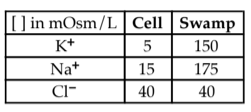An increase in body temperature causes
A. arrector pili muscles to contract.
B. an increase in keratinization of the skin.
C. sweating.
D. arterioles in the dermis to constrict.
E. an increase in melanin production.
Answer: C
You might also like to view...
In the cardiac cycle of mammals and birds, the ventricles fill mostly as a result of
A) Passive blood flow from the atrium. B) Forces of suction from ventricular expansion. C) Atrial contraction. D) High ventricular pressure.
For fun, you have used new molecular biology techniques to insert protein channels into the cell membrane that allow only Na+ and Cl- to pass. Predict which ion(s) will move. Tell what direction it (they) will move and what force(s) is/are acting on it (them).
We have finally discovered life on Venus. NASA scientists are investigating a newly discovered life form: a single-celled organism found in the swampy canals. You have been contracted by NASA to perform an electrophysiology study. Using intracellular electrodes to measure the electrical charge inside the cell, you find it has a resting membrane potential of -45 mV when the outside fluid is arbitrarily set to 0 mV. Additionally, you have determined ion concentrations and listed them below.

Rh antigen is also called
A) the D agglutinogen. B) anti-A. C) the A agglutinin. D) the R factor. E) the B agglutinin.
During exhalation of the first breath, the lungs do not collapse completely again in a newborn infant because
A) the incoming air is warmed by the upper portion of the respiratory tract, and this causes the lung tissues to expand and remain larger in size than previously, even when emptied of air. B) surfactant covering the alveolar surfaces prevents their collapse. C) exhalation is never as forceful as is inhalation. D) cartilages and connective tissues keep the conducting passageways closed. E) None of the answers are correct.